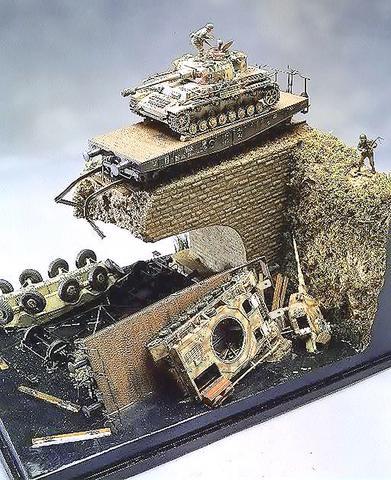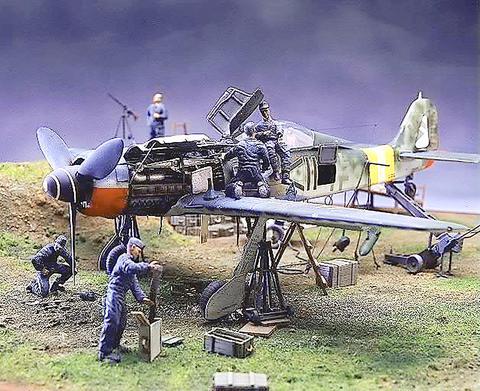Frequent visitors to MOCA and the Taipei Fine Arts Museum might look at it askance, but it would unfair to deny the model makers of the Miniatures Museum of Taiwan their due as consummate craftsmen.
However intricate, doll houses are not generally seen as art, and the complex issues of social commentary -- so dear to the hearts of contemporary artists -- are not to be found in the cool, dimly lit basement of the museum.

The most recent sideshow to the permanent collection, a display of military models, sees the horrors of war deftly put aside as model-makers set out to recreate scenes that, at one stage or another, have been close to every boy's heart. Except these model-makers, brought together by the publishers of Master Hobby Magazine (高手模型雜誌), have been building and painting models for many years, and it is their attention to detail and their manipulation of the ready-made model kits from which they start out, that fascinate the viewer.

PHOTO COURTESY OF MMOT
While the exhibition is not large, it shows much of the potential of the somewhat limited form of creativity. One display case is dedicated to the raw materials, the modular plastic units, that will make up the F16, Tiger Tank or whatever. Then there are the decals and paints, which are the subject of extended articles in Master Hobby Magazine and other similar publications, providing enthusiasts with exhaustive commentary on insignia and modifications to mechanized units.
A showcase of airplanes, ranging from early WWII craft to the latest in military technology are military modeling at their most mundane and are unlikely to provide much pleasure except to devotees of military arcana. The same goes for ships, although the incredible intricacy of some of the work cannot but attract your attention.
But the highlight of the show are the tableaux vivants of military scenes, which combine the model maker's and the set designer's art. This is not exactly A Bridge Too Far, and the powerful emotions of the scenes created are totally subsumed in the obvious delight the artists had in creating the scene.
"They [the model makers] pay attention to even such details as what kind of grass and bushes might have been at the scene of a certain battle or a certain season," said Koko Lin (林克真) of the MMOT. The little men who come out of the box in stiff poses are given life, their limbs torn off and welded back in more expressive positions.
Scenes from WWII form the bulk of the exhibition, which contains the work of over 20 artists. "There is more information available on this period than on any other," Lin said, so it is a particular favorite. The inclusion of models from the pre-mechanized era -- a galleon with full rigging is awe-inspiring if rather out of place -- and models from the fantasy and science fiction genres are unsuccessful inclusions, depriving the show of a clear focus.
Kids are bound to get a kick out of seeing a predominantly children's pastime taken to such heights, even though in the current climate of the war against terror, the adventurous aspect of war embodied in these models might seem a little out of place. But then, nobody has ever done much harm playing with toy soldiers.
The military model exhibition will be on show at the Miniatures Museum of Taiwan located at B1, 96, Chienkuo N Rd, Sec 1, Taipei (台北市建國北路一段96號B1) until Sept. 28.

May 26 to June 1 When the Qing Dynasty first took control over many parts of Taiwan in 1684, it roughly continued the Kingdom of Tungning’s administrative borders (see below), setting up one prefecture and three counties. The actual area of control covered today’s Chiayi, Tainan and Kaohsiung. The administrative center was in Taiwan Prefecture, in today’s Tainan. But as Han settlement expanded and due to rebellions and other international incidents, the administrative units became more complex. By the time Taiwan became a province of the Qing in 1887, there were three prefectures, eleven counties, three subprefectures and one directly-administered prefecture, with

It’s an enormous dome of colorful glass, something between the Sistine Chapel and a Marc Chagall fresco. And yet, it’s just a subway station. Formosa Boulevard is the heart of Kaohsiung’s mass transit system. In metro terms, it’s modest: the only transfer station in a network with just two lines. But it’s a landmark nonetheless: a civic space that serves as much more than a point of transit. On a hot Sunday, the corridors and vast halls are filled with a market selling everything from second-hand clothes to toys and house decorations. It’s just one of the many events the station hosts,

Two moves show Taichung Mayor Lu Shiow-yen (盧秀燕) is gunning for Chinese Nationalist Party (KMT) party chair and the 2028 presidential election. Technically, these are not yet “officially” official, but by the rules of Taiwan politics, she is now on the dance floor. Earlier this month Lu confirmed in an interview in Japan’s Nikkei that she was considering running for KMT chair. This is not new news, but according to reports from her camp she previously was still considering the case for and against running. By choosing a respected, international news outlet, she declared it to the world. While the outside world

Through art and storytelling, La Benida Hui empowers children to become environmental heroes, using everything from SpongeBob to microorganisms to reimagine their relationship with nature. “I tell the students that they have superpowers. It needs to be emphasized that their choices can make a difference,” says Hui, an environmental artist and education specialist. For her second year as Badou Elementary’s artist in residence, Hui leads creative lessons on environmental protection, where students reflect on their relationship with nature and transform beach waste into artworks. Standing in lush green hills overlooking the ocean with land extending into the intertidal zone, the school in Keelung